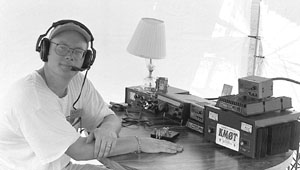


By Virginia Fries
They talk with astronauts in flight, work with authorities during emergencies and communicate around the world; they are radio "hams."
During a national field day Saturday and Sunday, June 26 and 27, members of the MID-land Amateur Radio Club set up operations on the grounds of the Blue Mound Inn near Luverne. The field day was sponsored by the Amateur Radio Relay League and involved operators across the country. It was designed to test the ability of amateur radio operators to set up and operate portable stations during emergencies.
Radio hams work with local, state and federal authorities, including the Federal Emergency Management Administration, the Red Cross, and the National Weather Service in the event of natural disasters and other circumstances.
M.A.R.C., a tri-state organization, was formed about one year ago. It has 14 members, including 11 licensed amateur radio operators. They hoped to contact up to 200 other amateur radio people during the 24-hour exercise.
Matt Hagin, Rock Rapids, club president, said there is no age limit on ham radio operators. He commented that there is a 12-year-old in Sioux City and another who is 92 years old. There are blind operators who use voice-activated radio equipment. Each one has his or her own "shack" (equipment and tower).
Members of the club agreed that ham radio will not be outdated by the advance of newer technology. In fact, they pointed out, amateur radio enthusiasts have contributed to much of the progress.
During the past 50 or more years, amateur radio operators have been instrumental in many radio and television developments, including very high and ultra high broadcast frequencies. They also worked with slow scan television, a part of the development of current television technology, and sent electronic mail to each other, the beginning of the e-mail concept.
Many United States astronauts are radio hams, according to Al Belk of rural Beaver Creek. He said they "talked with the guys on their way to the moon," and some astronauts have arranged to talk with school children in "windows" of their flight paths.
Belk a former Scoutmaster, said one of his Scouts, John Hallstrom of Madison, S.D., is currently an engineer with NASA who does the math to determine thrusts and changes in orbit. As a small boy, Hallstrom always had models of spacecraft in his room, according to Belk.
Ham radio operators don't limit their calls to the United States, according to Terry Martin of Sheldon, Iowa, club vice president. He had a display of cards confirming contacts with hams in Japan, Okinawa, Norway, Scotland, Tasmania, the Panama Canal Zone, Thailand, Greenland, Mongolia, Czechoslovakia, Israel, Hong Kong, East Germany, Ghana, Korea, Switzerland, the Mariana Islands and Kuwait. One contact made Saturday afternoon by LaDon Mott of LeMars, Iowa, was with a ham operator in Ontario, Canada.
Amateur radio operators are licensed by the Federal Communications Commission for experimental and public service work. Three of the club members expect to obtain their licenses very soon, according to Hagin. There are several publications available, but the best way to learn is from other hams, he commented. This is called "Elmering," he added with a smile.
Martin stressed that the purpose of the MID-land Amateur Radio Club is community service which extends beyond emergencies.
He commented that, as a part of this community concern, the club is taking part in the Adopt-A-Highway program. "We want to do something to help our member communities," he said.
For more information about M.A.R.C. or how to become involved in amateur
radio, people may contact Alan Meagher at (507) 669-6851.